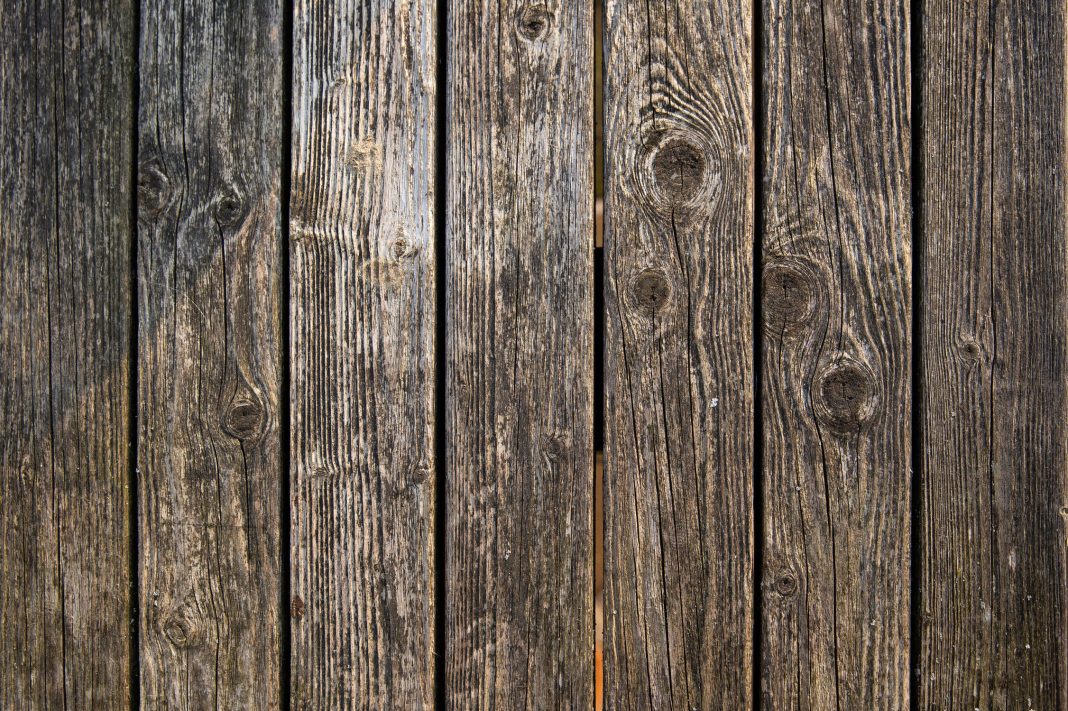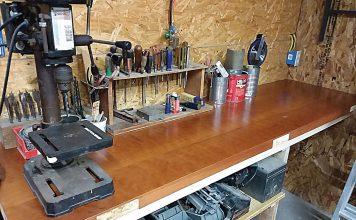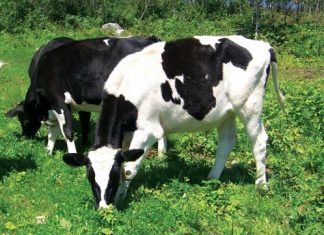By Charles Sanders |
 |
| Issue #103 • January/February, 2007 |
One of the basic fixtures on a homestead is fencing. Fences are used to keep animals in, or out, of areas. They are used to mark boundaries or provide attractive borders to properties.
You may think that a fence doesn’t need to be all that sturdy to contain your particular livestock. However, a horse using the top wire to scratch its neck, or a cow snuffling under the bottom wire to reach better grass can soon cause a lot of sagging and premature fence failure. In addition, you may be more concerned with keeping critters out than in. This is often the case when fencing sheep. It is not so much a problem to keep them in as it is to keep predators such as dogs and coyotes out. It is a case of wanting and needing to build a good tight fence.
Over the past 35 years or so, I have worked on a lot of fences. Below is some basic fence-building information, as well as a few twists that I have learned.
Fence posts
|
A fence can only be as good as the posts that hold it up off the ground. Fence posts are generally referred to by three different names: Corner posts; brace or slave posts; and line posts. Let’s take a look at the last of the three types, line posts.
Line posts are the ones that will run the length of your field or pasture. They are usually smaller in diameter than corner posts, often 3 to 5 inches. Right away, let me give you the benefit of my mistakes. Don’t skimp on the number of posts you use. Early in my fencing days, I tried to make a set number of posts cover more length than I should have. Instead of the 10-12 feet that I should have allowed between posts, I placed them about 16 feet or so apart. It wasn’t too long before the fence began to sag and I was going back and adding posts. So, remember to place your line posts no more than 10-12 feet apart when stretching barbed wire or woven wire. The added work and cost of adding the few extra posts will pay off.
Wooden or steel?
You may use wooden posts for which you will have to dig postholes or you might decide to use steel “T” posts, which may be driven into the ground with a sledge or post driver.
|
Steel posts are quick and easy to use, very durable, and come with wire clips that are used to attach the fence wire itself. A post driver is not much more than a piece of heavy steel pipe, closed on one end. It is placed down over the top of the post and repeatedly slammed down to drive the post into the ground. These work really well where few rocks are encountered. On my own rocky place, I have often had to shift the post one way or the other and re-drive it after hitting a large rock.
Store-bought post drivers are typically flimsy and break easily at the top due to the heavy pounding necessary to pound a post. I recommend you buy a heavy-duty homemade one at a garage sale, or have a welder make you one. My own post driver is made from a piece of old truck drive shaft. The end is heavy and solid and well able to withstand the repeated blows of driving the steel posts.
Wooden posts come in a wide variety of sizes and types. Depending upon where you live, some native woods make very good and long-lasting fence posts. In my area, some favorites are locust, cedar, mulberry, and Osage orange. Ask around in your own area. The locals should know which species make the best posts. If you are buying posts at a farm auction or auction house, be sure you know the species of wood the posts are made from. You don’t want to end up paying cedar prices for sassafras posts.

Preserving wood posts
One trick I learned from my dad is to coat the exposed end of wooden posts, particularly corner posts, with a thick coating of roof tar. This will seal the end against moisture and help to prolong the life of the post. I have also seen fence posts with bucket lids nailed to the tops to protect the end from the weather. Others I’ve seen had flashing covering the tops of the post, folded over and nailed into the sides of the posts. All of these will help to keep rain from soaking into the end of the post.
Soaking posts in a chemical preservative is another method of making posts last. Research the types of chemical you use to make sure they are not cancer-causing agents. You can also buy treated posts.
Today, chemicals used for preserving wooden posts include Alkaline Copper Quat (ACQ), Copper Azole (CA), and Sodium Borate (SBX).
Digging the hole
Of course, you’ll have to dig a hole for wooden posts. An auger attached to a tractor is a marvelous work-saving tool if you have a lot of holes to dig. (You can also rent a hand-held auger.) For fewer holes, you can use the old standby “clamshell” posthole digger. For corner posts, which are usually bigger than line posts, you may have to use a pick and shovel to augment the clamshell digger.
|
Setting wood posts
In most cases you can securely set the wood fence post by first placing it into the hole and lining it up with the others. Next, shovel a bit of dirt into the hole on each side of the post and tamp it in. I have a stout piece of 1¼ inch pipe that I use for a tamper. It is about 7 feet long and slightly bent at a point about 2½ to 3 feet from its lower end. This allows me to tamp the post and keep my knuckles from getting scraped on the post as I tamp. My dad had a piece of tough hickory that he used for a tamping rod. He cut the hickory pole about the same lengthabout seven feetand about 1½ inches in diameter. He put the piece of green wood between some stakes so that the same bend on the lower end was created. The piece was allowed to dry out in that position and when taken from the form, was permanently and perfectly shaped for tamping.
Keep adding a bit of dirt, then tamping, more dirt, more tamping, until you fill the hole. Any remaining dirt can be shoveled up around the base of the post and will help direct water away from it. It is important to add a little, tamp a little, add a little, tamp a little, until the post is solidly tamped in. If you try to add all the dirt at once and then tamp it in, the post will not be at all solid.
In cases where you have a lot of moisture in the ground, you can use a little gravel in the bottom of each hole to permit draining away from the post. Above the gravel you could use concrete around each post. In drier areas, however, dirt will suffice.
Fence corners
Your fence corners can pretty much determine how well your fence is going to bear up. Proper construction of fence corners and terminal points, such as gateposts, is essential. There is a tremendous amount of tension on a given run of fence and it takes some pretty stout posts and anchors to support it.
|
When constructing your corners, generally, you will want to use a larger and longer post. Today, treated corner posts of 6 to 8 inches in diameter are commonly available. They are usually about 7 to 8 feet in length and are set a bit deeper in the postholes, usually two and a half to three feet. I have used corner posts cut from long-lasting native woods, sections of used telephone and electric poles, old railroad crossties, “store-bought” treated posts.
A crosspiece will add stability to the corner. Crosspieces can be made from wood, pipe, old steel fence posts, or even old bed rails. In a couple of spots near the house, I had a few extra treated landscape timbers that I used. If you are using wooden posts, you can notch into the corner and brace posts and set the crosspiece into the notches. Tension supplied by the brace wire will hold the crosspiece in place. You might want to toenail the crosspiece into each post to be sure. That also helps keep the piece in place while you are constructing the corner. If you are using a pipe crosspiece, a nail in each post will give you a point from which to hang the pipe until you tighten the wires.
Brace wire is not the same as fence wire. It is usually available at supply stores in large coils for a nominal price. Brace wire is usually sold as #9 gauge and is fairly pliable. In a pinch, I have even used barbed wire as brace wire, but I don’t like to do that.
The critical part of constructing a post corner is the proper positioning of the brace wires. A properly constructed corner can be seen in the accompanying illustration A. If you are using a brace wire as shown, it is essential that the brace wire runs from the base of the corner post up to the upper portion of the brace post. This is because the tension is pulling against the wire. The top of the brace post is anchored to the most stable point on the corner post, the base.
If you are using a post as a diagonal brace, place it so that it runs from the top of the corner post towards the bottom of the brace post. That way, the tension would be pushing the most movable part of the corner post, the top, against the most stable part of the brace post, the base.
The brace wire
|
When placing the brace wire, you will be using just over twice the length of the span between the diagonal corners. That is, start a fence staple near the base of the appropriate post, run the wire up and around the other post and through another staple that you have placed at a point near where the top of the fence wire itself will be. Run the wire back down and through the same staple at the base of the first post.
Now there are a couple of ways to anchor the wire. Some folks run the wire back onto itself and make several wraps, then anchor it with a couple of staples. I have not found that to be necessary, however. I drive another staple slightly around the post from the first and run one end of the wire through it. Drive the staple in tightly then bend the wire back on itself. Do the same on the other side. Then you can add one or two staples on the loose ends to hold them securely in place. This arrangement will hold well.
The brace lever
Tension needs to be applied to the brace wire to make sturdy the corner post and brace post. Use a piece of wood, pipe, rod, or similar sturdy material. Cut a piece about 16 inches long. Place one end between the two strands of the brace wire that you have just secured. Simply begin twisting the wires, using the pipe or rod as a lever, to tighten them. Once you have them “taut as a drum head,” let the end of the lever rest against the horizontal brace that you have placed between the posts. Tension will likely keep the rod in place.
Choosing the wire
First of all, when buying fencing, it is easy to be tempted into buying the cheaper brands of wire. Let’s face it, fencing is not cheap to put up, either in terms of money or labor. However, I have found that fencing is like a lot of other thingsyou can pay for it now or you can pay for it later.
When you shop around for barbed wire, you will quickly notice a difference in the price of various brands. Barbed wire is one item where the cheaper brands have done all right for us overall. They stay bright and shiny with good galvanizing. It seems to me that they do tend to become somewhat brittle over many years, but I’ve noticed that mainly when repairing or removing a strand. I’ve been told that the higher price of the fence wire reflects the amount of copper contained in the wire. Since copper is relatively soft and malleable, this possibly accounts for the relative brittleness of the cheaper wire compared to the better workability of the higher priced wire.
|
Woven wire is sold by the gauge of the wire: The heavier the wire, the pricier the fencing. Remember that when you are sizing the wire, the greater the number, the smaller the wire’s diameter. That is to say that 12-gauge wire is heavier than 14-gauge wire. Also, the type of wire called “field fence” will not have the number of vertical wires as does regular woven wire. Field fence wire usually has the vertical wire or “stays” placed on 12 inch centers. Normal stock fence is 6 to 8 inches between the stays.
When it comes to buying and using woven wire, I have found that the cheaper brands just do not hold up. They are made of lighter gauge wire that is not tough or durable enough, especially if you have children who periodically use the fence for a ladder to the other side. On the rolls which I have used, the galvanized coating seems to have eroded away relatively quickly, so the wire rusts easily.
In short, go for the better brands of woven wire. It will be worth it. Benefit here from my experience and lapses in judgment.
Woven wire is manufactured with tension-producing crimps spaced along the run of wire. If you overstretch your fence wire as you are installing it, these crimps will be stretched beyond their limits and you will end up with a sagging fence. Similarly, if you do not provide sufficient tension when stretching the run of wire, time, gravity, and the weight of the wire itself will cause the fence to sag. Use fence stretchers, not just a tractor or truck to stretch wire. Fence stretchers or come-alongs provide gradual and adjustable tension on the run of wire. This is nearly impossible to do if just using a tractor or truck, when overstretching is the normal result. We’ll talk more about that in a minute.
Building a straight fence
To help ensure that the fence you are building is going to be nice and straight, simply set the corner posts first. Then run a twine or unroll a strand of barbed wire between the two. Temporarily secure the string or wire onto the corner posts so that it is suspended off the ground. Next, just step off and mark the locations for your line posts along that nice, straight wire or string.

Stretching the fence
One of the basic parts of constructing a fence is stretching it. This is done with either woven wire or with single barbed wire strands. Putting the right amount of tension on your new fence is critical to its effectiveness and ensures a long life. A fence that is too loose can allow livestock to find a way under, over, or through it. Animals can even become entangled in a loose fence causing damage to the fence, and worse, possible injury or death to the animal.
Always use some type of fence stretcher to put the pressure on your fence.
A wooden fence stretcher can be made from a couple of 2x4s and a half-dozen bolts. Use 2x4s that are a bit longer than the height of the woven wire you are using. Pair them up on their flat sides, then bore holes to accept the bolts you are using. Make the holes a bit larger than the diameter of the bolts to make it easy to install and remove the bolts when using the stretcher. In the photo, you can see some wooden fence stretchers at work in conjunction with a come-along and a chain.
Stretching barbed wire is a bit easier. Using one of the small fence clamps and a come-along, you can easily get the proper tension on the wire before attaching it to the posts. See the photo for an illustration of how these handy clamps work. The one in the photo is an antique that has been passed down from my father. It has helped to stretch a bunch of fence over the years.
The fence clamps are used to stretch a single strand of wire, usually barbed wire. The end of the clamp that hooks to the come-along is pushed to open the clamping jaws. The wire to be held is laid into the open groove, and the hook is pulled to close the clamp. Tension from the come-along and the barbed wire itself work to hold the clamp closed and the wire in place. The come-along is ratcheted until the wire is tight.
Attaching the wire
Now that the posts are set, the corners are built, and the wire is stretched, it is time to attach the wire.
When using wooden posts, ordinary fence staples are used. These are available in different lengths depending upon the type of wood your posts are made of. Generally, if you are using softer posts or posts with thick bark on them, use a longer staple. Harder woods require a shorter staple to do the same job. Believe me when I say that trying to drive an inch-and-a-half long staple into a locust post is not an easy task! That is what the inch staples are made for.
When driving fence staples, drive them at a slight angle to the vertical axis of the post. This keeps both points of the staple from sinking into the same vertical grain of the wood and possibly splitting it.
Tightening an existing fence
If you have a stretch of existing woven wire fence that is sagging, you can use a pair of fencing pliers to tighten it. It essentially uses your pliers to bend the wires and, in effect, shorten them to take the sag out of the run of fence.
Simply grab your pliers in both hands, open them, and place the open jaws vertically over the top wire of the fence. With a twist of the hands, move the pliers to horizontal, with the wire still in the open jaws. The wire will get a sort of “Z” bent into it. Proceed to the wire below and repeat. Continue the process all the way down to the bottom wire.
Depending upon the amount of sag in the fence, you may need to repeat the tightening between several rows of the wire stays.
You will likely be surprised at just how much slack can be taken up in the fence by using this tightening method.

Gateposts and bracing
If you are at the end of a fence run and plan to hang a gate there, you want to construct the fence at that point as you would a corner. That is, use a heavy corner post, a stout horizontal brace post, and diagonal brace wire from the base of the corner towards the top of the brace post. Now, since there will be the added weight of a heavy gate hanging on the corner post, add another diagonal wire running from the base of the brace post to the top of the corner post (or gate post in this case). In that way, the weight of the gate will be pulling the top of the corner post against the base of the brace post. This will make the gate less likely to sag.
Barbed wire gaps
In a case where you just don’t have a gate to hang, you can build what folks around here call a “gap.” A gap is simply a flexible gate made from the same fencing material you are using. It helps if you are using corner and brace posts as you would if you were hanging an actual gate, but I have seen gaps placed along fences where no corner posts were present.
If you need to put the gap in an existing run of fence, be sure to cut the wire near a post, but long enough to wrap it around the post and back onto itself. The other, loose ends of wire will need to have a length of wire spliced onto them to make the wire long enough to wrap around the gap post.
Take a look at the illustration and see how the gap is created. A loop of wire is placed around the line post near the bottom so the gap post can be secured in it. Another loop of wire is secured to the upper portion of the line post. One end of a sturdy lever is attached in one end of the loop. The other end of the lever is used to go around the gap post, levered and tightened, then placed into the other end of the wire loop.





















Greetings, too much for an old man. Can you recommend someone up here in Chehalis WA? Contractors welcomed.
Respectfully,
George
What length of woven wire can I stretch at one time? The wire I am using is 47” tall, 6” between stay wires, with 10 gauge top and bottom wires and 11 gauge wires elsewhere. Corners are triple H braced , there are single H braces every 70 ft and all wooden posts 10 ft apart. Thanks.
Thank you for your tip to buy better brands of woven wire when you’re choosing the fencing for your rural property. My brother just bought a beaten down farm and he needs to put up a new fence. I’ll pass this tip onto my brother so he can start shopping.